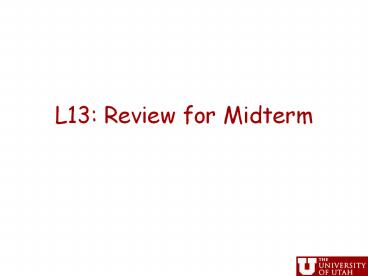L13: Review for Midterm PowerPoint PPT Presentation
Title: L13: Review for Midterm
1
L13 Review for Midterm
2
Administrative
- Project proposals due Friday at 5PM (hard
deadline) - No makeup class Friday!
- March 23, Guest Lecture
- Austin Robison, NVIDIA
- Topic Interoperability between CUDA and
Rendering on GPUs - March 25, MIDTERM in class
3
Outline
- Questions on proposals?
- Discussion of MPM/GIMP issues
- Review for Midterm
- Describe planned exam
- Go over syllabus
- Review L4 execution model
4
Reminder Content of Proposal, MPM/GIMP as Example
- Team members Name and a sentence on expertise
for each member - Obvious
- Problem description
- What is the computation and why is it important?
- Abstraction of computation equations, graphic or
pseudo-code, no more than 1 page - Straightforward adaptation from MPM presentation
and/or code - Suitability for GPU acceleration
- Amdahls Law describe the inherent parallelism.
Argue that it is close to 100 of computation.
Use measurements from CPU execution of
computation if possible - Can measure sequential code
- Remove history function
- Phil will provide us with a scaled up computation
that fits in 512MB
CS6963
5
Reminder Content of Proposal, MPM/GIMP as Example
- Suitability for GPU acceleration, cont.
- Synchronization and Communication Discuss what
data structures may need to be protected by
synchronization, or communication through host. - Some challenges on boundaries between nodes in
grid - Copy Overhead Discuss the data footprint and
anticipated cost of copying to/from host memory. - Measure grid and patches to discover data
footprint. Consider ways to combine computations
to reduce copying overhead. - Intellectual Challenges
- Generally, what makes this computation worthy of
a project? - Importance of computation, and challenges in
partitioning computation, dealing with scope,
managing copying overhead - Point to any difficulties you anticipate at
present in achieving high speedup - See previous
CS6963
6
Midterm Exam
- Goal is to reinforce understanding of CUDA and
NVIDIA architecture - Material will come from lecture notes and
assignments - In class, should not be difficult to finish
7
Parts of Exam
- Definitions
- A list of 10 terms you will be asked to define
- Constraints
- Understand constraints on numbers of threads,
blocks, warps, size of storage - Problem Solving
- Derive distance vectors for sequential code and
use these to transform code to CUDA, making use
of constant memory - Given some CUDA code, indicate whether global
memory accesses will be coalesced and whether
there will be bank conflicts in shared memory - Given some CUDA code, add synchronization to
derive a correct implementation - Given some CUDA code, provide an optimized
version that will have fewer divergent branches - Given some CUDA code, derive a partitioning into
threads and blocks that does not exceed various
hardware limits - (Brief) Essay Question
- Pick one from a set of 4
8
How Much? How Many?
- How many threads per block? Max 512
- How many blocks per grid? Max 65535
- How many threads per warp? 32
- How many warps per multiprocessor? 24
- How much shared memory per streaming
multiprocessor? 16Kbytes - How many registers per streaming multiprocessor?
8192 - Size of constant cache 8Kbytes
9
Syllabus
- L1 L2 Introduction and CUDA Overview
- Not much there
- L3 Synchronization and Data Partitioning
- What does __syncthreads () do?
- Indexing to map portions of a data structure to a
particular thread - L4 Hardware and Execution Model
- How are threads in a block scheduled? How are
blocks mapped to streaming multiprocessors? - L5 Dependence Analysis and Parallelization
- Constructing distance vectors
- Determining if parallelization is safe
- L6 Memory Hierarchy I Data Placement
- What are the different memory spaces on the
device, who can read/write them? - How do you tell the compiler that something
belongs in a particular memory space?
10
Syllabus
- L7 Memory Hierarchy II Reuse and Tiling
- Safety and profitability of tiling
- L8 Memory Hierarchy III Memory Bandwidth
- Understanding global memory coalescing (for
compute capability lt 1.2 and gt 1.2) - Understanding memory bank conflicts
- L9 Control Flow
- Divergent branches
- Execution model
- L10 Floating Point
- Intrinsics vs. arithmetic operations, what is
more precise? - What operations can be performed in 4 cycles, and
what operations take longer? - L11 Tools Occupancy Calculator and Profiler
- How do they help you?
11
Next Time
- March 23
- Guest Lecture, Austin Robison
- March 25
- MIDTERM, in class

